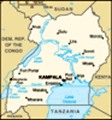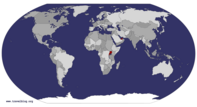Advertisement
Published: July 11th 2014
So, first off, I apologize for posting four blogs in a row, but power and internet have been minimal lately. First no power for several days, which is why the next two blogs are going to be short and might sound a little rushed – I quickly wrote them before my computer died. And then I didn't have a strong enough internet connection to post the blogs until now.
The next week at Kihefo involved some work at the clinic and group work, as per usual, but we also did some home visits and nutritional assessments of the community. As well, our team from MUST went back to Lake Bunyonyi, again, to visit the traditional healer.
One morning, 16 of us, which included some of our group members and hospital staff, crammed into the back of the ambulance and drove out to Lake Bunyonyi to visit the traditional healer. Yay. . . Leandra and I get to visit the man who ripped us off again. Our classmates knew what happened the first time we saw him and couldn't stop laughing at us the entire way there, right up until we were at his door. Once
at the lake, we all piled into a motorboat, this time with life jackets (well, for most of us – the exceptions being Ivan and Tonny, who graciously offered to drown if the boat tipped), and we were off to see the healer.
Dr. Anguyo, friend of the healer, was with us this time and since the visit was planned it was a little different from the first. A few of the healer's wives were present, and two performed dances for us once we entered his hut. Again, he showed us his medicine and equipment, but he also described some of the horns and antlers that decorated the walls. He then brought out an instrument that sort of resembles a harp and played it while the same two wives danced and sang for us. While it was a lot more interesting and entertaining than the first visit, and we got more out of it, it was hard to put our jaded emotions aside while he spoke to us. I will give him some credit though, he did explain the difference between him and witch doctors, saying that he is a Christian man and doesn't believe in using
gods and spirits to heal people. He told us how he used herbs and plants for his medicine, but acknowledges the limitations to his practice, and will send patients to Dr. Anguyo if he cannot cure them.
The following day were the home visits, which were originally organized for the girls from the States, but Leandra and I were allowed to join as work at the clinic continued to be slow. Before visiting the homes we stopped at the local school, where we would park the van for the day. As we were pulling up, the children were going nuts at the sight of a bunch of muzungus! We visited one of the classrooms where the children sang us a few of songs and danced for us. After this, we were broken up into groups of two volunteers and one translator. “Sarah and her friend,” our translator called. For whatever reason no one in Uganda can remember Leandra's name. Note: Leandra tried telling people her name was Leanne, but still no one remembered it. She even tried Lee, and Lilian, just for shits and giggles, but to no avail. She would forever be know at Kifeho as
“Sarah's friend.”
Each visit/assessment was a survey with questions covering everything from home conditions to diet to pregnancy history, and included malnutrition assessments of children under five years. Each visit took about one hour, so we only got to five homes on that day. Almost everyone interviewed were women, as they typically are the ones taking care of the home and children. However, sometimes there were several family members at home so we would speak to them as a group. Out of all the community work we did, the visits gave the best insight into the lives of those struggling the most in rural Uganda.
All the houses we saw were made of mud and bamboo, and lacked a floor, with the exception of one having a concrete floor. The dirt floors results in the houses becoming a mud pit during the rainy season, and being covered in dust during the dry season. Also, because diapers are far too expensive for the people to afford, the toddlers just don't wear bottoms to avoid laundry, further perpetuating the poor hygiene conditions. We even witnessed one child urinate on the floor, and the mother didn't even
react. None of the homes had any sort of power or running water and all people we interviewed said the nearest water source was quite a distance away. Because of this, only one home said they wash their hands. The rest of the families use all the water they carry home for drinking, cooking or washing clothes, all of which are more valuable uses of the limited water in their mind. The inside of the homes was really interesting to see first hand. The decor was obviously minimal; most with just a couple chairs or a small couch and a wobbly table. However, they all had at least a couple of pictures on the wall, and from what I could see, they were mostly either religious pictures of Mary and Jesus or political advertisements. I've been told one of the ways the current government stays in power is to visit the villages of the poorest people in Uganda and pay the locals for their vote. For the villagers, no matter who is in charge politically, their lives will not change, so many vote for whoever pays the best price.
We talked about educational history, discovering that most
have not finished their equivalent of high school, and we asked each person to read the sentence, “PARENTS LOVE THEIR CHILDREN”. While some could read a couple of the words, only one 19 year old girl was able to read it fully. This same girl was also the only woman who hadn't had multiple children, however she was recently a first time parent.
It seemed almost uncomfortably invasive to ask so many personal questions about the villager's lives. However, one thing that really surprised me was how open all of the people were to having us in their homes and allowing us to ask such questions. The first lady we interviewed was the most memorable for me. She was in her mid 20's, already had several children, and had been married for about ten years, although her husband was no longer with her. She faced away from us while we did the interview and seemed really sad answering the questions. At first, I thought maybe she was unhappy with the questions or didn't want to answer them, but later found out that she had seen the other American girls at her neighbour's house the day before. She
was hoping that we would come to her house so she could be a part of the surveys, as well. While a few of the interviewees asked if we could help them, she was the first. Many of the interviewees also asked what we were going to use the information for, and I explained that we were attempting to gain more knowledge about the village so to help them in the most appropriate way in the future. However, these people need so much help, in so many ways, and there is very little we can even do, at least in the short-term. The problems in Uganda are so intersectional, and to just target one aspect of need here is pretty well useless. There is poor sanitation and lack of clean water sources, or sometimes no near-by water source at all. Children are not getting a proper education, with the rates of completing high school being much lower in girls. This is hugely related to girls having children at a young age, dropping out, and continuing to pump out babies as long as their body will allow it. Most of these people can barely afford to feed themselves, let alone their
children. Only one of the families said they eat at least one meal a day, while all the others said they go about five to seven days every month without any food. Educating and empowering women here will be key for change, but that's a long road as they lack so many of the basic rights and freedoms we have back home. There is also government corruption and lack of accessible and reliable healthcare facilities. And all this just scratches the surface. I'll stop ranting, but I'm sure you get the picture.
Everyone we visited was so thankful that we came to speak to them, and like in the other communities they invited us to come back any time. One elderly lady was thrilled “muzungus” were in her home; we were likely the first white people she had ever spoken to.
During our downtime this week, Leandra and I learned how to do some more African cooking! We finally learned how to make the delicious chapattis that we love so much! I can't wait to try cooking these up at home. We also went to a local tailor with some fabric to get a
couple dresses made. Spoiler alert for next week: they didn't turn out as planned. Hopefully they can be re-tailored into something that fits when I get back home, otherwise I'm sure the fabric will make for a couple nice throw cushions. Oh, and I got kissed and groped by a strange man on the street near the market. Sadly, this isn't the first time this happened to me – a bum kissed me when I was in NYC last summer. I think my friends are right when they say I'm too nice and need to be more assertive. Oh well!
Anyways, bye for now!
Advertisement
Tot: 0.105s; Tpl: 0.012s; cc: 15; qc: 71; dbt: 0.0726s; 1; m:domysql w:travelblog (10.17.0.13); sld: 1;
; mem: 1.3mb










